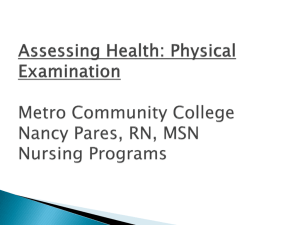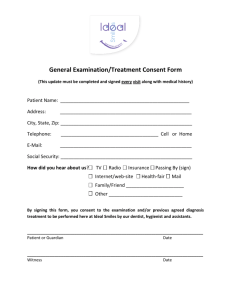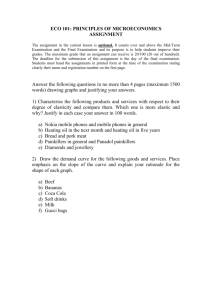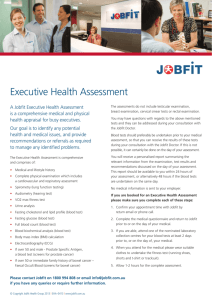Each of the examination components listed on the Final
advertisement
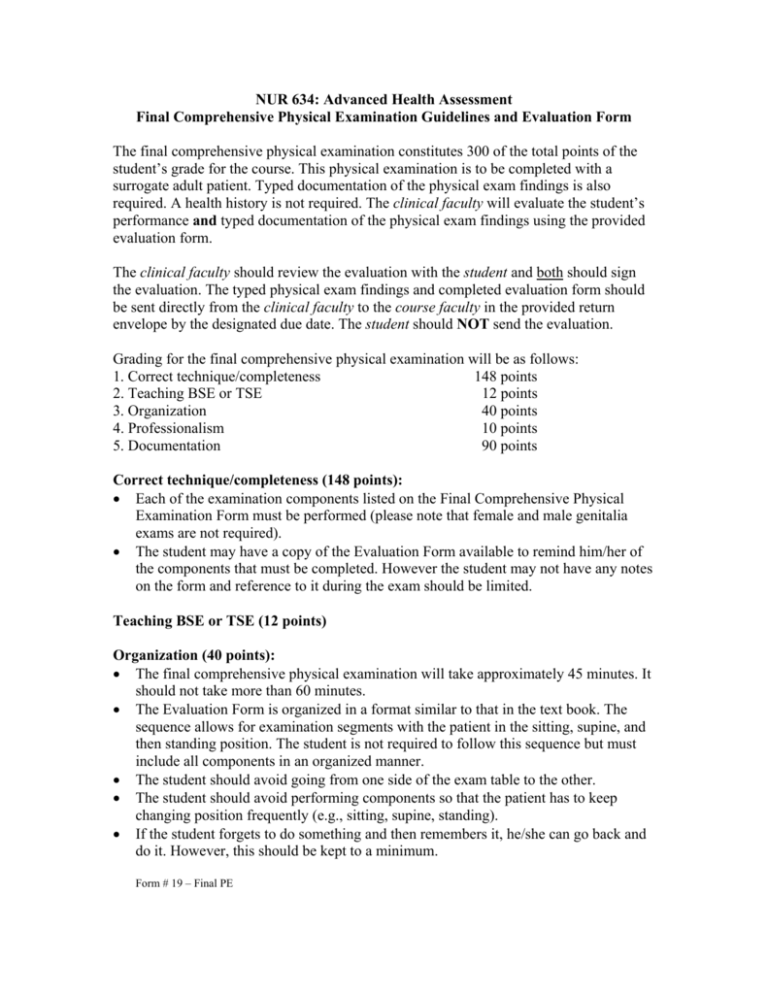
NUR 634: Advanced Health Assessment Final Comprehensive Physical Examination Guidelines and Evaluation Form The final comprehensive physical examination constitutes 300 of the total points of the student’s grade for the course. This physical examination is to be completed with a surrogate adult patient. Typed documentation of the physical exam findings is also required. A health history is not required. The clinical faculty will evaluate the student’s performance and typed documentation of the physical exam findings using the provided evaluation form. The clinical faculty should review the evaluation with the student and both should sign the evaluation. The typed physical exam findings and completed evaluation form should be sent directly from the clinical faculty to the course faculty in the provided return envelope by the designated due date. The student should NOT send the evaluation. Grading for the final comprehensive physical examination will be as follows: 1. Correct technique/completeness 148 points 2. Teaching BSE or TSE 12 points 3. Organization 40 points 4. Professionalism 10 points 5. Documentation 90 points Correct technique/completeness (148 points): • Each of the examination components listed on the Final Comprehensive Physical Examination Form must be performed (please note that female and male genitalia exams are not required). • The student may have a copy of the Evaluation Form available to remind him/her of the components that must be completed. However the student may not have any notes on the form and reference to it during the exam should be limited. Teaching BSE or TSE (12 points) Organization (40 points): • The final comprehensive physical examination will take approximately 45 minutes. It should not take more than 60 minutes. • The Evaluation Form is organized in a format similar to that in the text book. The sequence allows for examination segments with the patient in the sitting, supine, and then standing position. The student is not required to follow this sequence but must include all components in an organized manner. • The student should avoid going from one side of the exam table to the other. • The student should avoid performing components so that the patient has to keep changing position frequently (e.g., sitting, supine, standing). • If the student forgets to do something and then remembers it, he/she can go back and do it. However, this should be kept to a minimum. Form # 19 – Final PE • Cranial nerve assessment may be incorporated throughout other segments of the exam. The student should indicate verbally when he/she is assessing a particular cranial nerve and the name of the nerve. Professionalism (10 points): • The student should dress and act professionally during the final examination. • Appropriate instructions and explanations should be provided to the patient during the exam. • Attention should be given to providing for patient comfort and privacy during the exam. Typed Documentation (90 points): • Typed documentation should be organized, complete, and concise. • Correct terminology and spelling are considered in evaluation of documentation. Form # 19 – Final PE Ball State University School of Nursing NUR 634: Advanced Health Assessment Final Comprehensive Physical Examination Evaluation Form Student Name _______________________________ Date ___________ Important Instructions Perform all listed examination components. Provide appropriate instructions and explanations to the patient. Provide for patient comfort and modesty during the examination. Describe aloud your exam findings as if you were dictating as you do the exam. Male and female genital examination will be omitted. Document (typed) your physical examination findings. Points Possible General Survey (throughout exam) 5 Posture, motor activity, gait (1) Dress, grooming, personal hygiene (1) Facial expression, affect, mood (1) Manner of speaking (1) State of awareness (1) Skin (throughout exam) Head 3 5 Hair (1) Scalp (1) Skull (1) Face (1) Temporomandibular joints (1) Eyes 13 Visual acuity (2) Position and alignment (1) External eye structures (1) Conjunctiva and sclera (1) Cornea, iris, lens, pupils (1) Pupillary reaction to light & accommodation (2) Extraocular muscles – corneal reflex, conjugate movements, convergence (2) Ophthalmoscopic – optic disk, retina (3) Ears 7 Auricles (1) Ear canals (1) Ear drums (2) Auditory acuity(1) Air and bone conduction – Weber, Rinne (2) Nose and Sinuses External nose (1) Nasal mucosa & septum (1) Frontal and maxillary sinuses (2) 4 Points Received Comments Mouth and Pharynx 5 Lips & oral mucosa (1) Gums and teeth (1) Tongue, roof, floor of mouth (1) Pharynx (1) Tonsils (1) Neck 7 ROM (2) Lymph nodes –name as assess (2) Trachea (1) Thyroid (2) Posterior Thorax and Lungs 13 Breathing movements (1) Spinous processes & paravertebral muscles (1) AP diameter (1) Chest expansion (2) Tactile fremitus (2) Percussion sounds (2) Breath sounds (2) Transmitted voice sounds (2) Upper Extremities 18 Skin and nails (1) Lymph nodes - epitrochlear (1) Pulses – brachial, radial (2) Joints (2) ROM (2) Motor system – muscle bulk, tone, strength (3) Coordination – rapid alternating movements, finger to nose (2) Sensory system (choose 2) – pain, light touch, vibration, position (2) Discriminative sensations (1) Reflexes (choose 2) – biceps, triceps, brachioradialis (2) Breasts 6 Inspection - sitting and supine (2) Palpation – supine (2) Lymph nodes – axillary, supraclavicular, infraclavicular (2) Anterior Thorax and Lungs 3 Breathing movements/use of accessory muscles (1) Breath sounds (2) Cardiovascular System Inspection – jugular venous pulsations (2), apical impulse (2) Palpation – carotid arteries (2), precordium (2), apical impulse (2) Auscultation – carotid arteries (2), heart sounds (2) 14 Abdomen 17 Inspection (1) Auscultation – bowel sounds (1), bruits (1) Percussion – quadrants (1), liver span (2), spleen (2) Palpation – light and deep (1), liver (2), spleen (2), kidneys (2), aorta (2) Lower Extremities Skin and nails (1) Lymph nodes - inguinal (1) Pulses – femoral, posterior tibial, dorsalis pedis(2) Joints (2) ROM (2) Motor system – muscle bulk, tone, strength (3) Coordination – heel to shin (1) Sensory system (choose 2) – pain, light touch, vibration, position (2) Reflexes (choose 2) – quadriceps, Achilles, plantar (2) CN I – XII – may check during other sections of exam (6) Standing 16 6 6 Spine ROM (2) Gait (2) Romberg (1) Pronator Drift (1) Teaching 12 BSE – female patient TSE – male patient Organization Professionalism Typed Documentation 40 10 90 Organization (15) Completeness (25) Conciseness (15) Terminology (25) Spelling (10) Total Points 300 Comments: Student Signature ____________________________________ Date_____________ Faculty Signature_____________________________________ Date_____________ Form # 19 – Final PE 3/08



